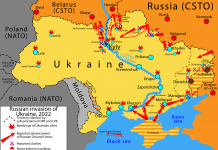
Armenia is reportedly engaging in discussions with Hindustan Aeronautics Limited (HAL) to procure Su-30MKI fighter jets, a strategic move aimed at enhancing its air force capabilities. This potential acquisition serves as a secondary approach to upgrading military assets, complementing Armenia’s initiative to modernize its existing fleet of Su-30SM fighters into the “Super Flanker” variant through HAL.
Armenia’s plans to enhance its air fleet have been in consideration for some time. Earlier in 2023, reports indicated that the Armenian Air Force was interested in integrating advanced Indian weapon systems, such as the BrahMos air-to-ground missiles and Astra air-to-air missiles, which are co-developed by Russia and India. Colonel Ovanes Vardanyan, head of Armenia’s Air Force, confirmed ongoing discussions with HAL regarding these enhancements. He acknowledged HAL’s significant experience in aircraft modernization, expressing interest in collaborative opportunities in avionics, electronic warfare, and armament systems.
An unnamed official from India corroborated Armenia’s interest but noted that talks are still in preliminary stages. He highlighted that the Armenian Su-30SM variant differs from the Indian Su-30MKI, implying that tailored modifications may be necessary during the upgrade process.
The potential acquisition of eight to twelve Su-30MKIs could considerably impact the existing political dynamics between Armenia and Russia. The Su-30MKI is an Indian modification of the Russian Su-30SM, developed and manufactured under Russian licensing. Transitioning to this aircraft may signal a shift in Armenia’s defense alignment, suggesting a diversification away from traditional Russian influence in military technology and partnerships.
Russia has historically regarded the South Caucasus as a region of strategic interest, providing Armenia with military support under preferential terms. A pivot toward India for defense procurement might prompt Moscow to reassess its relationship with Yerevan, possibly perceiving it as an intention to reduce reliance on Russian military resources. Such a shift could heighten tensions and result in less favorable conditions for future arms deliveries from Russia.
Military analysts, including Alexey Leonkov, have expressed skepticism regarding the efficacy of modernization efforts, suggesting that Russian technology for the Su-30SM may outperform alternatives in combat scenarios. He noted that while Armenia’s decision to modernize with India could stem from burgeoning partnerships and military cooperation, it risks undermining traditional military ties with Moscow.
Analyst Alexander Gushchin indicated that a strengthened Armenia-India alliance could represent a strategic shift in the regional power balance, potentially compelling Russia to reevaluate its commitments to Armenia within the framework of the Collective Security Treaty Organization (CSTO).
For Armenia, collaborating with India presents an opportunity to enhance its military capabilities amid rising tensions in the region. The acquisition of Su-30MKIs would not only bolster India’s defense manufacturing reputation but also solidify its position as a key supplier of military equipment, reinforcing India’s influence in the Caucasus—a region of significant geopolitical interest.
The historical context illustrates Armenia’s frustrations with Moscow. In 2019, Armenia ordered four Su-30SM jets, but deliveries lacked crucial munitions, limiting operational effectiveness. Additionally, delays in receiving further aircraft, purportedly due to the ongoing conflict in Ukraine, have exacerbated Armenia’s security concerns. Reports suggest that some of these jets may have been redirected to support Russian operations, further straining relations.
In light of unmet needs for missile systems and logistical support, Armenia has begun to explore alternative sources for military procurement. The urgency to strengthen defense capabilities against escalating regional threats has prompted Yerevan to diversify its military partnerships.
Armenia’s military diversification extends beyond India. In October 2023, Armenia signed a significant arms agreement with France, marking its inaugural procurement of Western military equipment. This deal includes radar systems, armored personnel carriers, and missile systems, alongside training for Armenian military personnel. These initiatives align with Armenia’s broader strategy to mitigate reliance on Russian military support while enhancing defense capabilities amid increasing tensions with Azerbaijan.
Furthermore, Armenia is pursuing anti-drone systems from India, valued at approximately $41 million, and is exploring potential agreements with the European Union for non-lethal military assistance. This diversification of defense sources is crucial as Armenia seeks to bolster its security in the face of ongoing regional instability.




